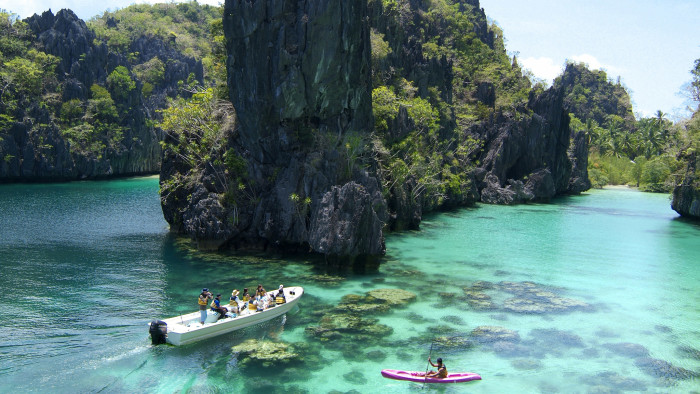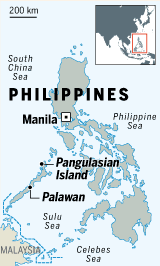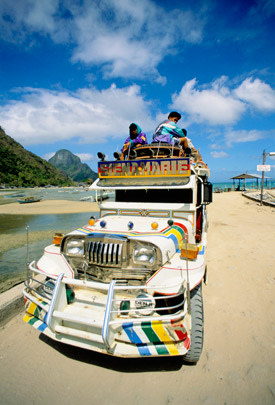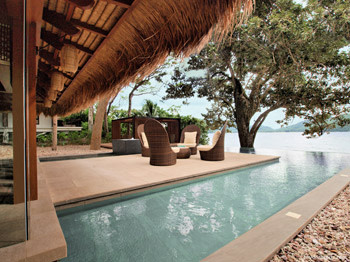The Philippines’ final eco-frontier

Simply sign up to the Life & Arts myFT Digest -- delivered directly to your inbox.
The wood-panelled aircraft hangar in Manila seemed to have materialised from a Graham Greene novel. In the brief wait for my flight to Palawan, I took tea under a ceiling fan, among rattan furniture and pot plants. It all evoked a less frenetic era of air travel.
Once aboard the 19-seater Dornier, I could watch the banter in the cockpit. The turboprop cruises at lower altitudes than a jet, hence the riveting views during the 90-minute flight south, as skyscrapers gave way to forested islets with enticing white coves and haloes of turquoise.
The Philippine capital is only two hours’ flight from Hong Kong, which I had been visiting to chair the jury of a literary award. The day after the Man Asian prize banquet in the Peninsula hotel, I met up with my partner in Manila, demob-happy after months of intensive reading. The aim was tranquillity in natural surroundings – with enough to do for a week not to have to pick up another novel.
Palawan proved an inspired choice. Of the Philippine archipelago’s 7,107 islands, a quarter are in this least-populated, least-developed province, which retains more than half its original forest cover and is known nationally, and promoted by the tourist board, as the country’s “last frontier”. With visitor numbers rising sharply, the challenge is to preserve the astounding biodiversity of this Unesco biosphere reserve, home to marine sanctuaries and rare wildlife. No longer a secret of divers, birdwatchers and backpackers, Palawan is spawning luxury resorts, the newest of which, on Pangulasian Island, was my ultimate destination.

Mainland Palawan, 450km long, is shaped like a folded umbrella (Spanish colonists called it Paragua), whose tip points southwest, almost touching Borneo. I headed for its handle in the north, to El Nido, a protected area whose Spanish name derives from swiftlets’ edible nests. Still harvested (now for a single season when the birds are mature), these nests hug the towering limestone cliffs of Bacuit Bay on the South China Sea.
I landed in possibly the world’s most charming airport, with greenhouses filled with lettuces and a resident water buffalo. The El Nido airstrip serves the four properties run by the El Nido Resorts group, a local pioneer in sustainable eco-tourism. Just after my visit, it won the Community Benefit Award at the World Travel and Tourism Council’s Tourism for Tomorrow awards – the latest in a string of such accolades.

Ninety per cent of employees are local, but El Nido Resorts’ mission to educate goes beyond its staff. The instructional videos in the thatched-roof, open-air terminal, extolling solid waste management and desalination to waiting passengers may seem surreal, yet the message is imparted with firm grace and a welcoming song. Jeepneys (developed from the Jeeps left behind by US troops in the second world war and now a ubiquitous presence throughout the country) painted with marine life relayed us to a jetty, where bancas – traditional outriggers with bamboo floats – ferried passengers on to the island resorts: “one island, one resort”.
There is something of The Land That Time Forgot in the ancient karst limestone shapes that rise up from Bacuit Bay – most of whose 45 islands are uninhabited by humans. Their foliage recalls Chinese paintings, while the area is geologically akin to Vietnam’s Ha Long Bay, rather than the Pacific “ring of fire”. The non-volcanic soil grows few crops, other than peerless mangoes (served in juices and desserts) and cashews, but the local palms sprout even on hilltops.
My first stay was on tranquil Lagen Island, in an over-water cottage with mesh doors to deter swiftlets from nesting. I was mesmerised not only by the drama of the cliffs, but by turquoise jack fish swimming in the crystal water beneath me. At low tide, a monitor lizard slunk through mud into the mangroves.
The cottages on stilts, reached via cliffside walkways draped in bougainvillea, maximise the scant space in the cove. Much is built from recycled wood, in a place where you need a licence to own a chainsaw. I admired details, from brown-clay pathlights shaped like the endemic pitcher plants, to origami swiftlets fashioned from pandan leaves.
Guests are urged to use the resorts’ biodegradable soaps and to refill metal flasks with safe drinking water from water stations – tiny models of the cottages.
Lagen’s marine sports and eco-guide Rowin Abin took us first to Snake Island, named for the serpentine sandspit where two currents meet, which stretches to the mainland and shifts with the monsoons. Strolling along it as the tide came in gave the illusion of walking on water. On Miniloc Island, we kayaked through a narrow gap to a placid green lagoon that serves as a fish nursery and is surrounded by bonsai-like foliage.
I also walked Lagen’s rainforest trail, where dao tree roots like rocket fins are incorporated into the stepped path, and sniffed at the fragrant, analgesic sap from the eucalyptus-like sahing tree. We descended into a far cove just as a black-and-white striped falcon swooped down.
At another perfect coral beach on Entalula island, I swung idly in a hammock listening to the hornbills until it was time to picnic on grilled whole fish and seafood. Spanish influence pervades the cuisine, fused with American, Chinese and Mexican tastes.
Over a poolside drink, Mariglo Laririt, El Nido Resorts’ longstanding environment director, spoke with passion about marrying profit with preservation. For her, even the Materials Recovery Facility – a waste recycling plant on the mainland – is a point of pride. Treated sewage is also recycled for watering plants and flushing toilets.

“Our first managers were turtle guys,” she recalls. In the late 1970s, two Japanese brothers, businessmen and diving enthusiasts, chanced on the bay. Joining forces with local turtle conservationists, they opened the first resort, Miniloc, in 1982 as a diving camp for Japanese executives. The deluxe Lagen opened in 1998, and the company changed hands. Since 2001, El Nido Resorts has been owned and run by the Asian Conservation Company, founded the previous year after a brainstorming session in the area, organised by an arm of the WWF, on how to finance conservation. The company professes a so-called “quadruple bottom line” that makes goals of conservation and community development alongside employee satisfaction and shareholder profit. Its founding chairman, Vicente Pérez, also chairs the Philippines’ branch of the WWF.
Miniloc, still modelled on coastal villages’ thatched nipa huts, has moved on in some respects. I stayed in a glass-fronted beach room with a marble bathroom and wooden screens to draw against the sunrise. Though clearly still a favourite with divers, it could also lay on a romantic dinner, with starlit boat ride to a private, candlelit beach. A spa on stilts allowed for pampering to the sound of imperial pigeons and splashing waves. Yet the credo was clear in a light-hearted slideshow at the beach bar, when the resort’s environment officer described the habits of skinks and whale sharks.
The latest island resort, Pangulasian, opened last December, on a south-facing promontory that catches both sunrise and sunset. I stayed in a spacious thatched-roof beach villa, with contemporary Philippine design that maintained a simple elegance, and made ornamental use of traditional musical instruments. Though villas come with a personal butler, and the resort uses golf carts and plushly upholstered speed boats, there is still pride in being “low-impact.”
Canopy villas tower on stilts to leave roots undisturbed. Except for the two-storey reception, the resort is scarcely visible from the sea. After some guided snorkelling – when the apparently docile blacktip reef sharks stayed away – I took a steep nature trail, arousing the curiosity of some long-tailed macaques. A viewing deck gave a panorama of Bacuit Bay, my understanding of it by now transformed.
On my return to Manila, the aeroplane had grown to a 48-seater – a harbinger of things to come. In a government push for tourism in the Philippines, 12 regional airports are being revamped for international flights, including Palawan’s capital, Puerto Princesa. Infrastructural upgrades mean a drive to El Nido that once took up to two days now takes four hours. The hope is that Palawan’s fragile beauty can withstand the new tide.
——————————————-
Maya Jaggi was a guest of Audley Travel (www.audleytravel.com), which can arrange tailor-made itineraries to the Philippines from £2,995 per person for 10 nights, based on two sharing, including flights from London, three nights’ bed & breakfast at the Manila Hotel, and seven nights’ full-board at El Nido’s Miniloc Resort
Comments